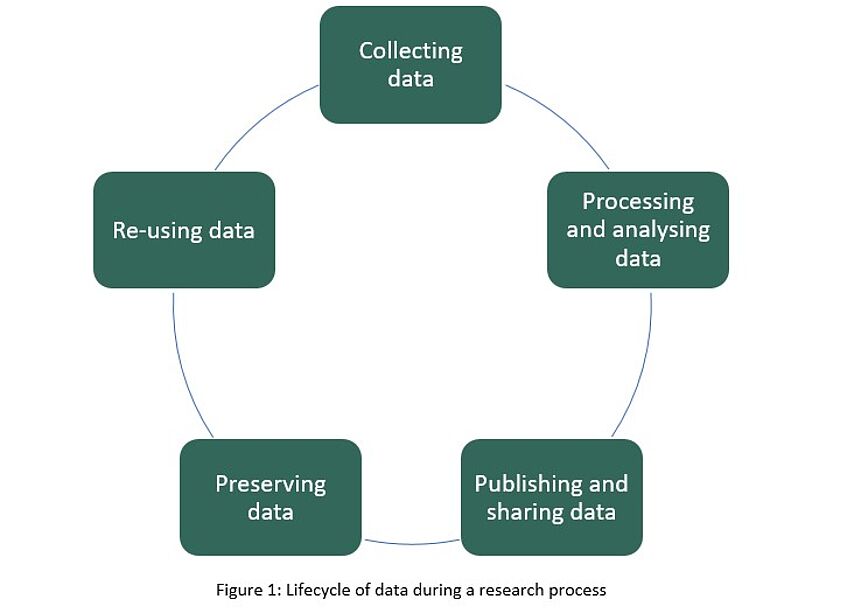The Data Lifecycle: Exemplified by the HOLIFOOD project

The Data Lifecycle: Exemplified by the HOLIFOOD project
UNIVIE has been part of the HOLiFOOD project since October 2022. The main objective of the project is to develop an early warning system for food risks and to validate methods and devices for the identification and characterization of existing and (re-)emerging hazards (chemical and biological). For further information about the project read here. UNIVIE’s role in the project primarily consists of assisting partners with implementing the general requirements in existing and upcoming European legislations (e.g. GDPR, Digital Governance Act and AI Act) in relation to the data processing. In addition, UNIVIE conducts legal research, defines the legal framework for the project in light of future legal acts and explores their application to the processing operations within the project.
For most research projects, it has now become a requirement to develop a data management plan (DMP) in line with the European Commission’s FAIR principles for research data. The DMP provides an initial overview on the type of data to be collected and how this data is stored, organised and protected. However, the DMP is not a set in stone document, and evolves over the course of the project and beyond. For more information about the DMP and the FAIR principles, see our blogpost from our past project, TheFSM here. The next few paragraphs will briefly explain the lifecycle of data during a research and innovation project.
The data lifecycle
1. Collecting data
The first step involves the process of gathering information from various sources. The purpose of data collection is to deriving information and make informed decisions. During this step, it needs to be determined what data is necessary and where it can be found. Furthermore, the legal basis for data processing must be established.[1] In the HOLiFOOD project administrative data, stakeholder data, platform data and software data is collected.
2. Processing and analysing data
Data processing refers to a series of operations performed on data to verify, organize, transform, integrate and extract information. An appropriate output form is essential to reduce the risks of data harm. It should be taken into account that data sets may be interpreted in different ways, which may lead to falsified results if the data has not been carefully verified.
3. Publishing and sharing data
As a further step, considerations about sharing and publishing the data should be made. It is widely agreed in the research field, that data sharing helps scientific progress and ensures a better use of resources.[2] Nevertheless, when research data is made accessible, one has to prepare the data set for access, determine the appropriate audience and outline the rules governing data sharing. Data Sharing Agreements may be a suitable approach for sharing data among partners and data users. The European Data Governance Act is a further legal instrument set up to facilitate data sharing across sectors and EU countries, in order to maximize the potential of data for the benefit of EU citizens and others.
4. Preserving data
Preserving data should allow researchers to assess the data quality for enabling reuse. Data preservation might be possible through different methods, which are best combined with each other: On the one hand, a correct designation according to standards should be chosen, in order to make future accessibility easy. On the other hand, digital resources must be available where these data can be stored to maintain its functionality.[3]
5. Reusing data
In recent years, there has been an exponential increase in the volume of data generated. Therefore, at the beginning of a project it is necessary to decide whether to produce new data or to reuse existing data. Additionally, at the end of a project it must be determined to what extent data should be made accessible for reuse. When data fall under the category of restricted data, specific action and use conditions are in place, limiting accessibility and reusability.[4] In this case, it is also important to obtain permission for the use of data from the responsible partners or data subjects.
For all the steps described, researchers must comply with the legal framework and ethical foundations for data processing. In the HOLiFOOD project, UNIVIE is assisting the project partners by providing legal advice on the data lifecycle and aspects of data use. If you would like to know more about the project or be informed about future events, click here.
Sources
[1] UK Data Service, Research Data Management, www.ukdataservice.ac.uk/manage-data/lifecycle.aspx (lastly accessed 15.05.2023)
[2] Fischer J, Zigmond MJ, The essential nature of sharing in science. Sci Eng Ethics. 2010;16: 783-779. pmid:21108019 The Essential Nature of Sharing in Science | SpringerLink (lastly accessed 15.05.2023)
[3] Faniel, Ensberg, Shaw, Hull, Moore, Preservation of Research Data for Reuse, 2015, phaidra.univie.ac.at/detail/o:429527 (lastly accessed 15.05.2023)
[4] Ghent University, Reusing existing data, www.ugent.be/en/research/datamanagement/before-research/data-reuse.htm (lastly accessed 15.05.2023)
